Guppies are one of the most popular freshwater fish for aquariums, known for their vibrant colors, active nature, and peaceful temperament. However, creating a harmonious community tank with guppies requires a careful selection of tank mates. Not all aquatic creatures are compatible with guppies, but there are plenty of great options that can coexist peacefully. In this article, we’ll explore the Top 21 Compatible Tank Mates for Guppies, including fish, snails, and shrimp. Let’s dive in!
Guppy Fish Overview
Before we dive into the compatible tank mates for guppies, let’s take a quick overview of Guppy Fish.
| Category | Details |
|---|---|
| Scientific Name | Poecilia reticulata |
| Common Names | Guppy, Millionfish, Rainbow Fish |
| Origin | Native to northeast South America, found in countries like Venezuela, Brazil, and Trinidad and Tobago |
| Size | 1.5-2.5 inches (4-6 cm) |
| Lifespan | 2-3 years (with proper care) |
| Diet | Omnivorous – enjoys a mix of high-quality flakes, live foods (brine shrimp, daphnia), and veggies |
| Temperament | Peaceful and social; ideal for community tanks |
| Tank Requirements | Minimum 10 gallons; water temperature 72-82°F (22-28°C); pH 6.8-7.8; well-planted tank with space |
| Breeding | Livebearers; easy to breed; females can give birth to 20-200 fry at a time |
| Care Level | Beginner-friendly; hardy and adaptable |
| Special Notes | Guppies thrive in groups (3 or more); frequent small water changes promote optimal health |
Key Factors to Consider When Choosing Tank Mates
When selecting tank mates for guppies, it’s important to consider the following factors:
- Temperament: Guppies are peaceful fish and thrive with other non-aggressive species.
- Tank Conditions: Guppies prefer warm water (72–82°F), slightly alkaline pH (7.0–8.0), and good filtration.
- Size: Avoid large or predatory fish that may view guppies as food.
- Diet Compatibility: Ensure all tank mates share similar dietary needs.
With these considerations in mind, let’s explore the best tank mates for guppies.
Fish Tank Mates for Guppies
1. Cory Catfish (Corydoras paleatus)

Corydoras catfish are peaceful bottom-dwellers that make excellent tank mates for guppies. These small, social fish are known for their scavenging habits, helping to clean the tank by eating leftover food and debris.
- Size: 1–3 inches
- Behavior: Corydoras are non-aggressive and prefer to stay at the bottom of the tank, which complements guppies’ mid-to-top water column activity.
- Tank Requirements: Soft sand substrate is essential to protect their sensitive barbels. They thrive in groups of at least 4–6.
- Diet: Corydoras feed on sinking pellets, algae wafers, and leftover food.
- Key Benefit: They keep the substrate clean and add diversity to the tank.
- Care Needs: Soft substrate to protect their sensitive barbels.
2. Platies (Xiphophorus maculatus)

Platies are livebearers, just like guppies, and they share similar environmental needs. They come in a wide variety of colors and patterns, adding diversity to your aquarium.
- Size: 2–3 inches
- Behavior: Peaceful fish that get along well with guppies. Males can be mildly territorial, so maintaining a proper male-to-female ratio (1:2 or more) is essential.
- Tank Requirements: Thrive in planted tanks with moderate lighting.
- Diet: Platies eat flakes, pellets, and vegetable-based foods like blanched spinach or zucchini.
- Key Benefit: Their similar care requirements make them a low-maintenance and visually appealing option.
- Care Needs: Provide a well-planted tank for hiding spots.
3. Mollies (Poecilia sphenops)
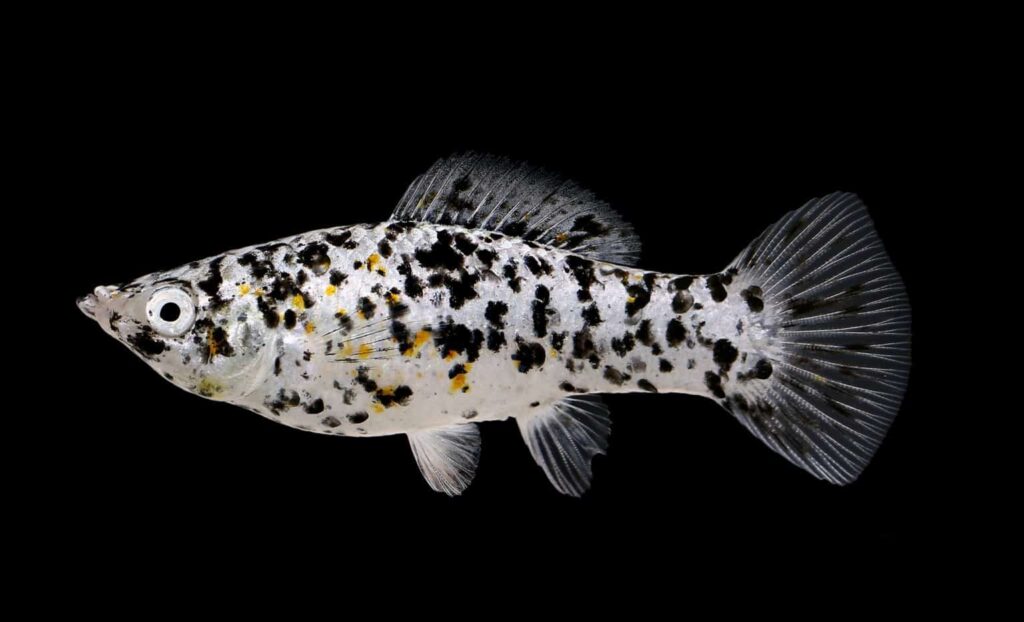
Mollies are close relatives of guppies and are just as colorful and active. They are hardy and adaptable, although they prefer slightly brackish water.
- Size: 3–4 inches
- Behavior: Peaceful but slightly larger than guppies. They do well in groups and rarely show aggression.
- Tank Requirements: They thrive in freshwater but benefit from a small amount of aquarium salt.
- Diet: Omnivorous and enjoy flakes, pellets, algae wafers, and vegetable-based foods.
- Key Benefit: Their similar behavior and vibrant appearance make them a natural match for guppies.
- Care Needs: Provide brackish water if possible, though they can adapt to freshwater.
4. Neon Tetras (Paracheirodon innesi)
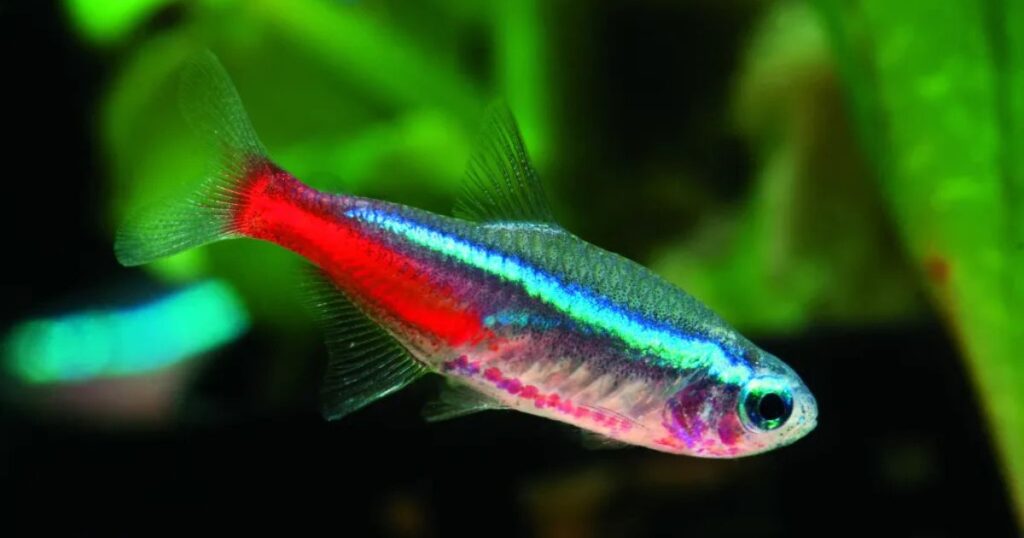
Neon tetras are small, schooling fish that are highly compatible with guppies due to their calm and peaceful nature. Their bright blue and red stripes make them a visually stunning addition to any tank.
- Size: 1.5 inches
- Behavior: Neon tetras are schooling fish and should be kept in groups of at least 6–8 to reduce stress.
- Tank Requirements: Prefer soft, slightly acidic to neutral water (pH 6.0–7.0), but they can adapt to guppy-friendly conditions.
- Diet: Flakes, micro pellets, and live or frozen foods like brine shrimp or daphnia.
- Key Benefit: Their vibrant colors complement the guppies’ beauty, creating a lively, colorful aquarium.
- Care Needs: Keep in groups of at least 6 for their well-being.
5. Harlequin Rasboras (Trigonostigma heteromorpha)
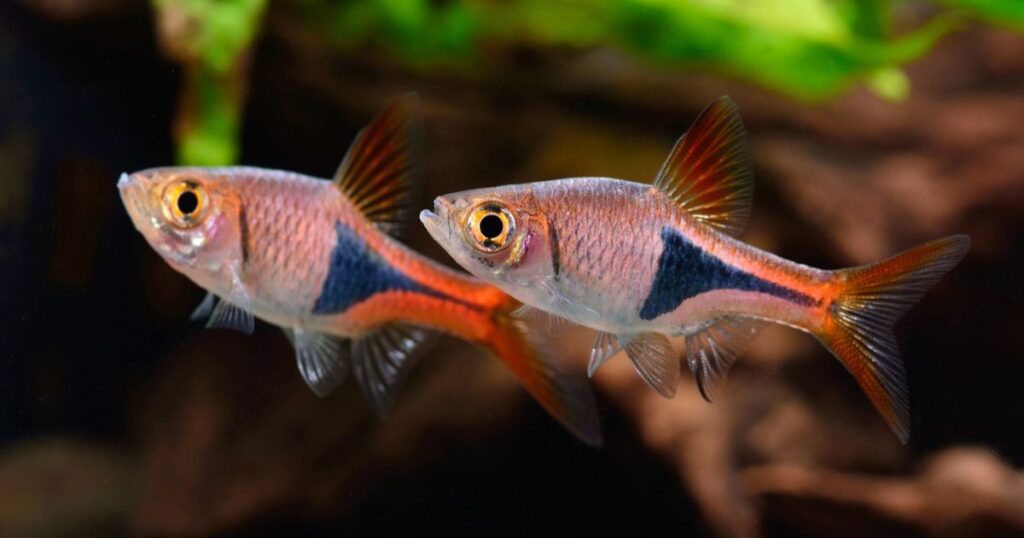
Harlequin rasboras are peaceful schooling fish that share similar water conditions with guppies. Their copper-orange bodies and black triangular markings make them stand out.
- Size: 1.5–2 inches
- Behavior: Active swimmers that stay in groups of 6 or more, creating a dynamic and harmonious tank environment.
- Tank Requirements: Prefer a planted tank with open swimming spaces.
- Diet: Omnivores that accept flakes, micro pellets, and live or frozen foods.
- Key Benefit: They are hardy and easy to care for, making them a great addition to beginner tanks.
- Care Needs: Keep in groups of 6–8 for best results.
6. Endler’s Livebearers (Poecilia wingei)

Endler’s livebearers are closely related to guppies and share similar care needs. They are smaller and often more vibrantly colored than guppies, creating a stunning display in the tank.
- Size: 1–2 inches
- Behavior: Peaceful and energetic, they coexist happily with guppies.
- Tank Requirements: Thrive in planted tanks with stable water parameters.
- Diet: Flakes, live baby brine shrimp, and other small foods.
- Key Benefit: Their small size and vivid colors make them ideal companions for guppies.
- Care Needs: Fine with guppies in well-maintained tanks.
7. Kuhli Loach (Pangio kuhlii)

Kuhli loaches are peaceful, eel-like fish that stick to the bottom of the tank. They are nocturnal and shy, making them a non-threatening addition to a guppy tank.
- Size: 3–4 inches
- Behavior: Spend most of their time hiding during the day and foraging at night.
- Tank Requirements: Need a soft substrate and plenty of hiding spots like caves or driftwood.
- Diet: Will eat sinking pellets, frozen foods, and occasionally detritus.
- Key Benefit: Their unique, snake-like appearance adds diversity.
- Care Needs: Provide hiding spots, as they are nocturnal.
8. Cherry Barbs (Puntius titteya)

Cherry barbs are one of the calmer species of barbs, making them compatible with guppies. Their bright red coloration adds a unique flair to the tank.
- Size: 2 inches
- Behavior: Semi-schooling fish that prefer groups of 5 or more. They are active but non-aggressive.
- Tank Requirements: Prefer a well-planted tank with hiding spots.
- Diet: Omnivorous and eat flakes, pellets, and live or frozen foods.
- Key Benefit: Their vibrant red color contrasts beautifully with guppies.
- Care Needs: Keep in groups of at least 5.
9. Dwarf Gourami (Trichogaster lalius)
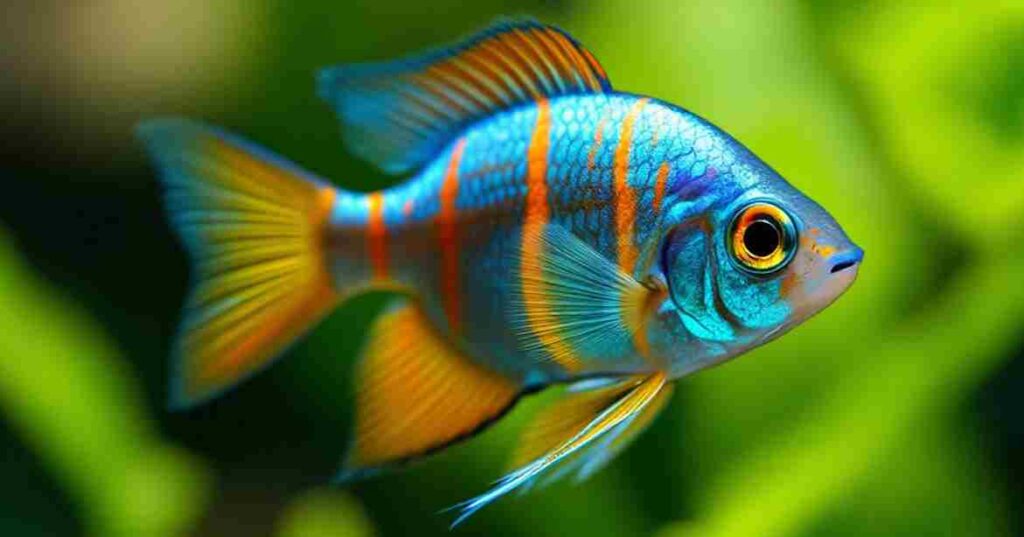
Dwarf gouramis are peaceful centerpiece fish that can live harmoniously with guppies when given enough space.
- Size: 3–4 inches
- Behavior: Slow-moving and shy, dwarf gouramis do well in peaceful community tanks.
- Tank Requirements: Require a well-planted tank for hiding and a calm environment.
- Diet: Omnivorous and eat flakes, pellets, and frozen or live foods like bloodworms.
- Key Benefit: Their unique appearance adds variety to a guppy tank.
- Care Needs: Provide a planted tank with hiding spots.
10. Dwarf suckers (Otocinclus Catfish)
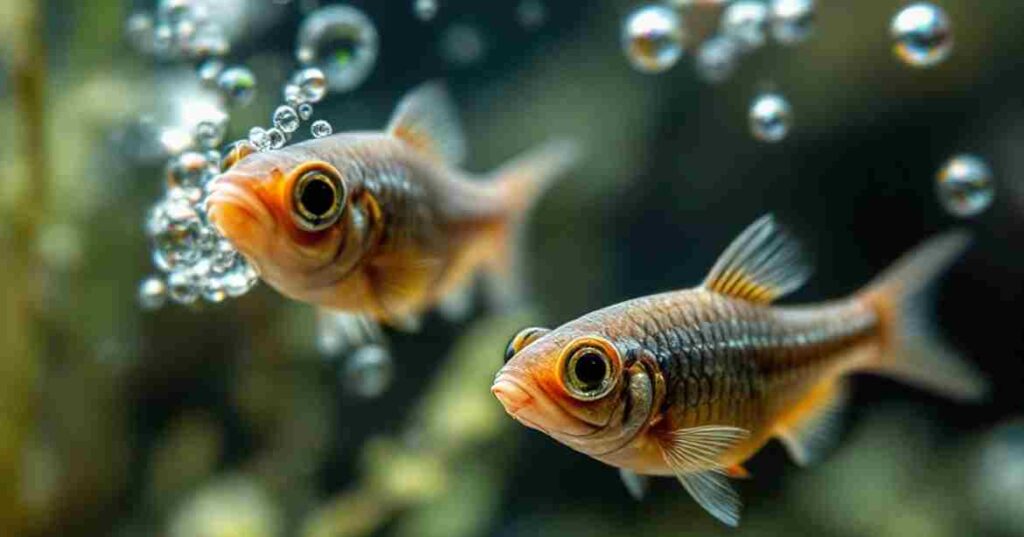
Dwarf suckers, or “otos,” are small algae eaters that are perfect for a guppy tank. They are peaceful and will not bother guppies.
- Size: 1–2 inches
- Behavior: Spend most of their time on tank surfaces eating algae.
- Tank Requirements: Require a steady supply of algae or supplemental food like algae wafers.
- Diet: Herbivorous, focusing on algae and vegetable matter.
- Key Benefit: Excellent algae cleaners that reduce maintenance.
- Care Needs: Provide a steady supply of algae or algae wafers.
11. White Cloud Mountain Minnows (Tanichthys albonubes)
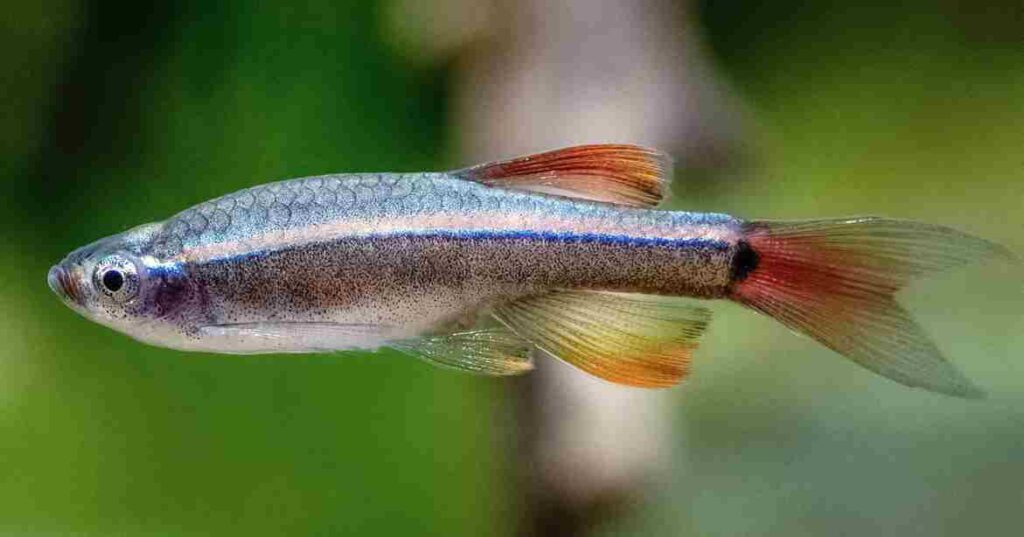
White cloud minnows are hardy and colorful fish that can tolerate a wide range of conditions, including guppy-friendly water parameters.
- Size: 1.5 inches
- Behavior: Schooling fish that thrive in groups of 6 or more.
- Tank Requirements: Prefer cooler water but adapt to guppy tanks.
- Diet: Omnivorous and eats flakes, pellets, and micro foods.
- Key Benefit: Their hardiness makes them a low-maintenance option.
- Care Needs: Thrive in groups of 6+.
12. Celestial Pearl Danios (Danio margaritatus)
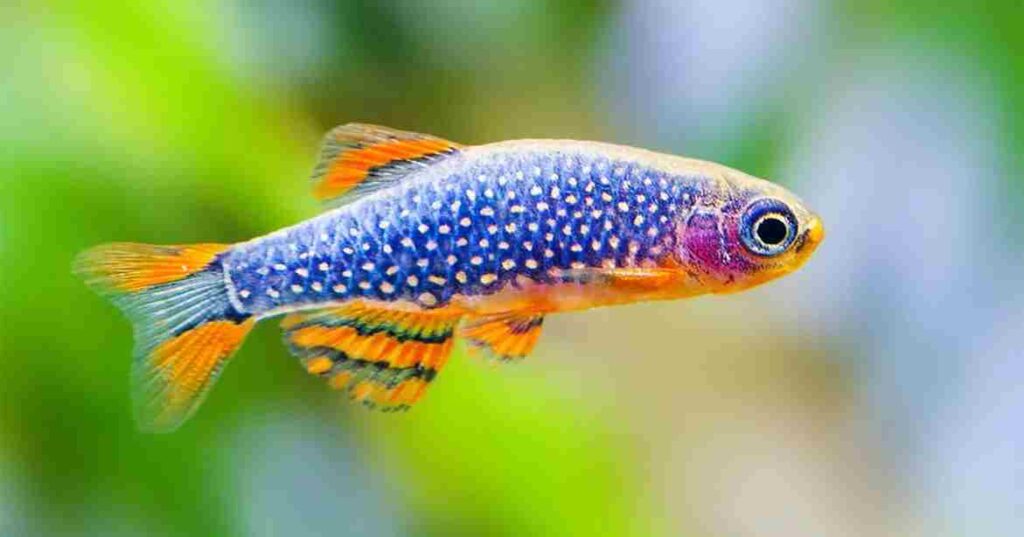
Also known as galaxy rasboras, these tiny fish are peaceful and stunningly beautiful, with iridescent spots that resemble stars.
- Size: 1 inch
- Behavior: Active but shy, they thrive in groups of 6 or more.
- Tank Requirements: Prefer a planted tank with subdued lighting.
- Diet: Micro pellets, flakes, and live or frozen micro foods.
- Key Benefit: Their small size and peaceful nature make them a great match for guppies.
- Care Needs: Keep in groups of 6 or more for comfort.
Snails as Tank Mates for Guppies
Adding snails to your guppy tank enhances its beauty and functionality. Plus, they’re natural cleaners that help maintain water quality.
13. Mystery Snails (Pomacea bridgesii)
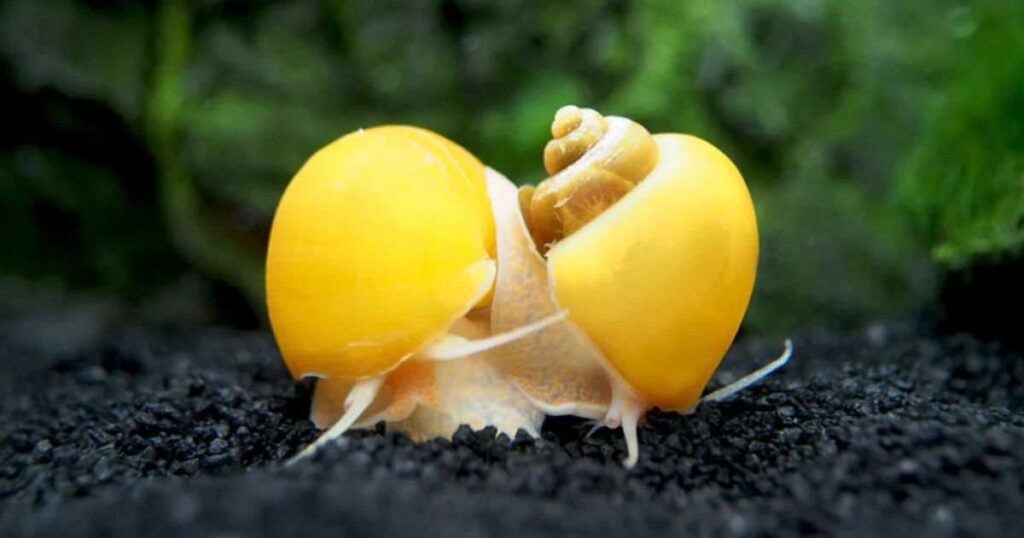
Mystery snails are large, active snails that come in a variety of colors. They are excellent at cleaning algae and leftover food.
- Size: 2 inches
- Behavior: Peaceful and non-aggressive.
- Tank Requirements: Need a secure lid, as they may climb out of the tank.
- Diet: Algae, leftover food, and vegetables like zucchini or spinach.
- Key Benefit: Their active nature and vibrant shells add interest to the tank.
- Care Needs: Ensure proper calcium levels for shell health.
14. Nerite Snails (Neritidae)

Nerite snails are small, hardy snails that are excellent algae eaters. They cannot reproduce in freshwater, so there’s no risk of overpopulation.
- Size: 1 inch
- Behavior: Peaceful and stay out of the way of guppies.
- Tank Requirements: Need calcium for shell health and prefer hard water.
- Diet: Algae and biofilm.
- Key Benefit: Excellent at controlling algae without breeding issues.
- Care Needs: Cannot reproduce in freshwater, so no risk of overpopulation.
15. Ramshorn Snails (Planorbella magnifica)
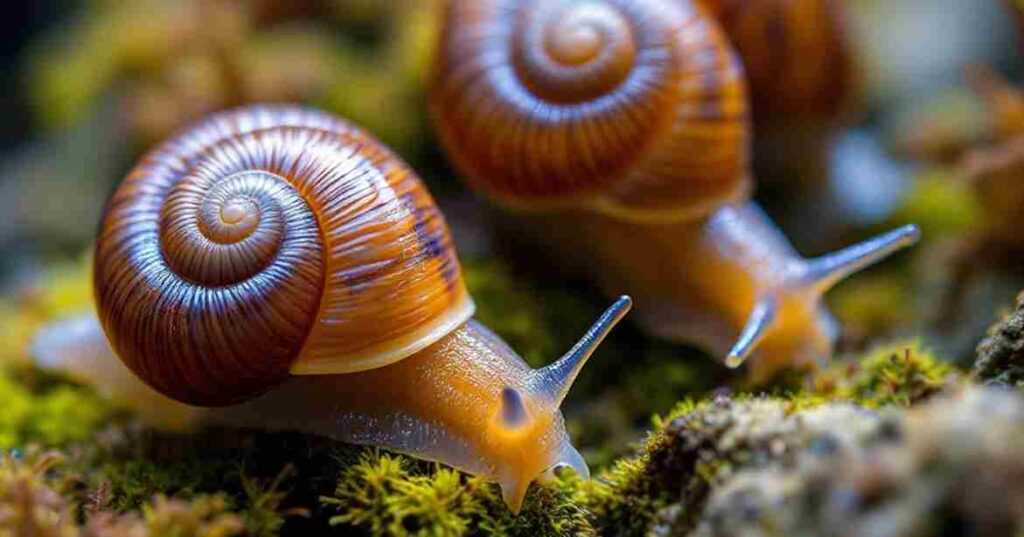
Ramshorn snails are small and prolific tank cleaners. They add a unique spiral shell design to the tank.
- Size: 1 inch
- Behavior: Active and peaceful.
- Tank Requirements: Can multiply quickly, so avoid overfeeding.
- Diet: Algae and decaying plant matter.
- Key Benefit: Great for cleaning but requires population control.
- Care Needs: May reproduce quickly if overfed.
16. Pond Snails (Lymnaea stagnalis)
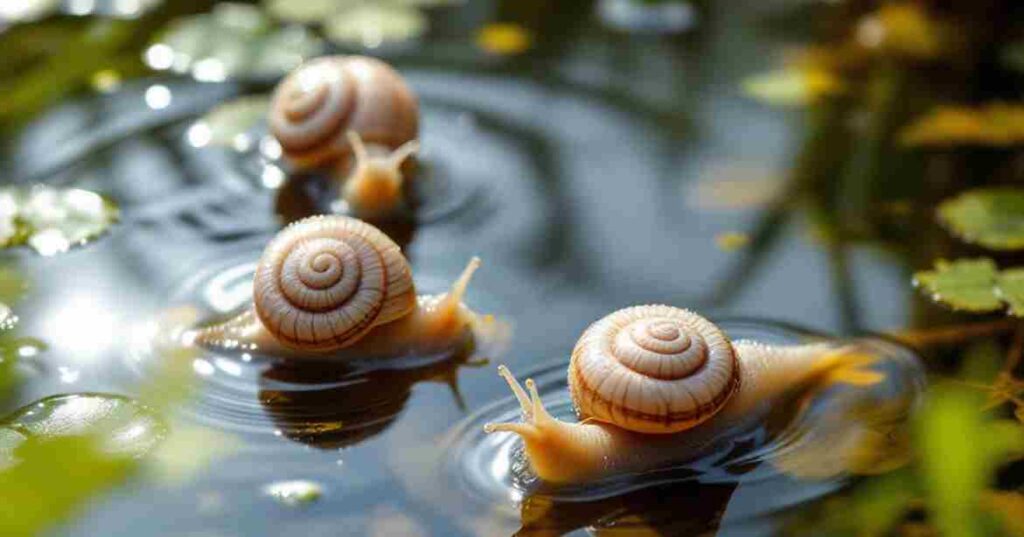
Pond snails are small, hardy snails that help clean the tank. They are low-maintenance and compatible with guppies.
- Size: 1 inch
- Temperament: Peaceful
- Care Needs: May become invasive if overfed.
Shrimp as Tank Mates for Guppies
Shrimp add a bit of excitement and uniqueness to your tank. They’re peaceful and thrive alongside guppies.
17. Cherry Shrimp (Neocaridina davidi)
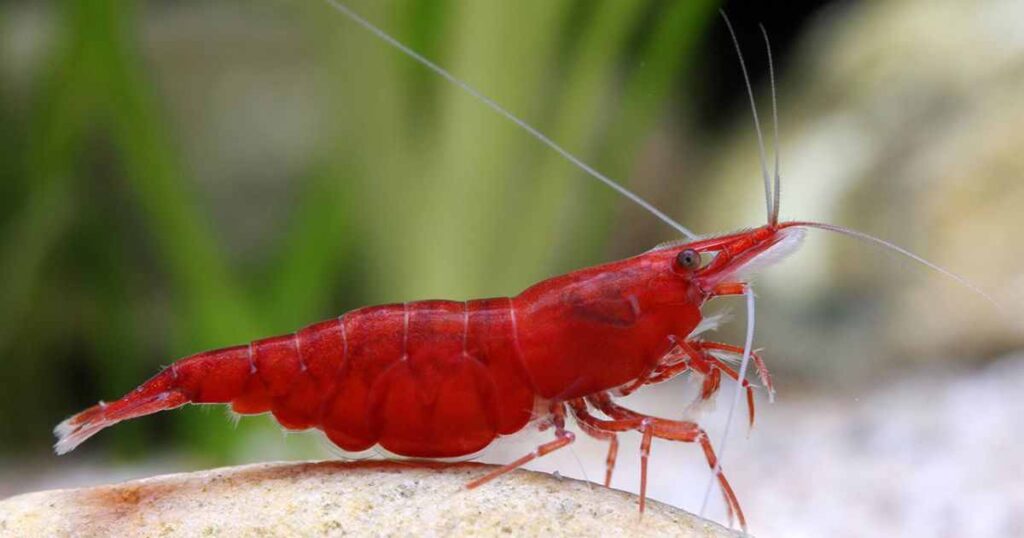
Cherry shrimp are one of the most popular shrimp species in freshwater aquariums. Their bright red coloration adds a pop of vibrancy to your tank, and their peaceful nature makes them ideal companions for guppies.
- Size: 1–1.5 inches
- Behavior: Cherry shrimp are non-aggressive and spend most of their time grazing on algae and biofilm. They are active during the day, but they may hide if they feel threatened.
- Tank Requirements:
- Provide plenty of live plants and moss for hiding spots.
- Cherry shrimp require stable water conditions, as they are sensitive to sudden changes in parameters.
- Diet: They consume algae, biofilm, and sinking shrimp pellets. Supplement their diet with blanched vegetables like zucchini or spinach.
- Key Benefit: Cherry shrimp help keep the tank clean by eating algae and detritus while adding a splash of red to the aquarium.
- Care Needs: Provide plants and moss for hiding.
18. Amano Shrimp (Caridina multidentata)
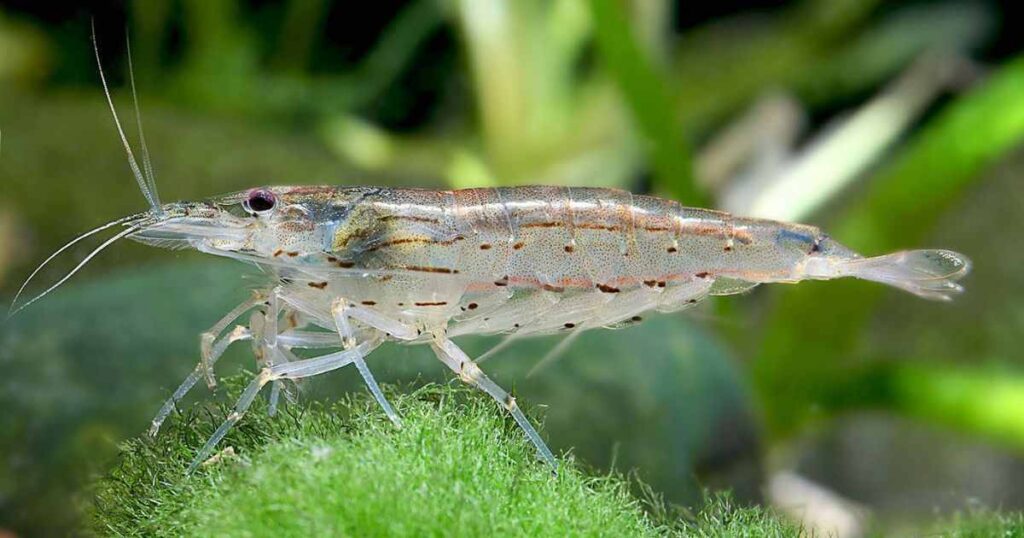
Amano shrimp are larger than cherry shrimp and are highly valued for their incredible algae-eating abilities. They are hardy and can adapt well to a guppy tank, provided there are no aggressive tank mates.
- Size: 2 inches
- Behavior: Peaceful and active, Amano shrimp spend their time scavenging or eating algae. They are highly social and should be kept in groups of 3 or more.
- Tank Requirements:
- A well-planted tank with hiding spots is ideal.
- They prefer clean, well-filtered water with stable parameters.
- Diet: Amano shrimp thrive on algae, leftover food, and sinking shrimp pellets. They will also eat blanched vegetables.
- Key Benefit: These shrimp are among the best algae cleaners and can help reduce tank maintenance.
- Care Needs: Thrive in planted tanks.
19. Ghost Shrimp (Palaemonetes paludosus)

Ghost shrimp are transparent, inexpensive shrimp that are commonly used in freshwater aquariums. They are hardy and can coexist peacefully with guppies if there are enough hiding spots in the tank.
- Size: 1.5 inches
- Behavior: Ghost shrimp are peaceful but active scavengers. They spend most of their time foraging for food at the bottom of the tank.
- Tank Requirements:
- Provide hiding spots, such as caves, driftwood, or dense plants, to protect them from curious guppies.
- They thrive in a clean, stable environment with good water quality.
- Diet: They eat algae, leftover fish food, and sinking pellets. Occasionally, they can be fed live or frozen foods like daphnia or bloodworms.
- Key Benefit: Ghost shrimp are low-maintenance and excellent tank cleaners while adding a unique look to your aquarium.
- Care Needs: Provide hiding spots to protect them from curious guppies.
20. Bamboo Shrimp (Atyopsis moluccensis)
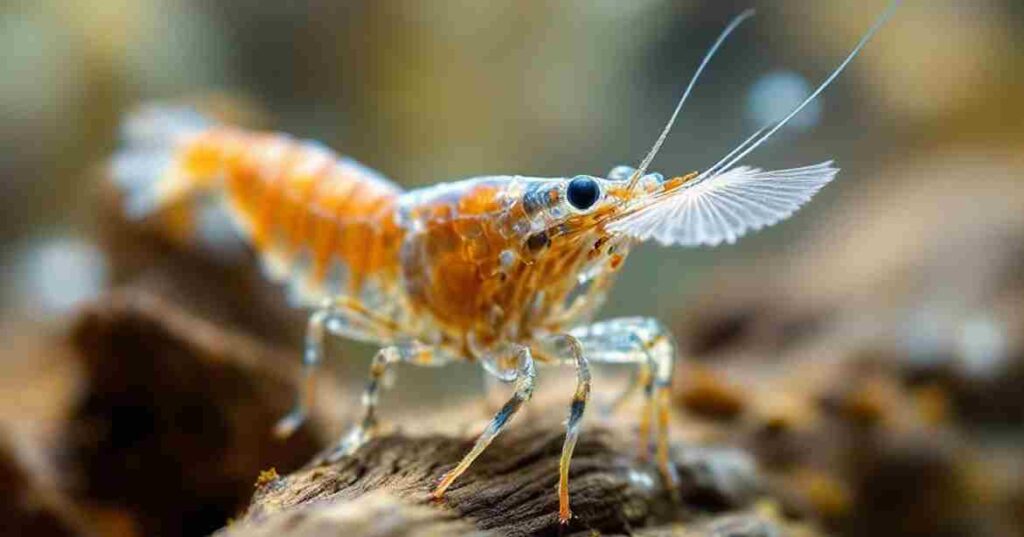
Bamboo shrimp are filter-feeding shrimp that use their fan-like appendages to catch food particles from the water. They are larger than most other shrimp species, making them less likely to be mistaken for food by guppies.
- Size: 2–3 inches
- Behavior: Bamboo shrimp are peaceful and spend much of their time near areas of water flow, where they can filter-feed.
- Tank Requirements:
- A well-established tank with good water circulation is essential for their feeding habits.
- They require high water quality and stable parameters.
- Diet: They feed on microscopic particles, algae, and detritus. In a low-food environment, you can supplement their diet with powdered shrimp food or ground fish flakes.
- Key Benefit: Bamboo shrimp are fascinating to watch as they filter-feed, and their larger size ensures compatibility with guppies.
- Care Needs: Provide a steady flow of water for filter feeding.
21. Blue Velvet Shrimp (Neocaridina davidi var. blue)

Blue velvet shrimp are a color variant of cherry shrimp, featuring stunning blue hues that add a unique aesthetic to your tank. Like cherry shrimp, they are peaceful, easy to care for, and excellent tank cleaners.
- Size: 1–1.5 inches
- Behavior: Non-aggressive and active, these shrimp peacefully coexist with guppies, provided there are sufficient hiding spots to protect them from curious fish.
- Tank Requirements:
- A planted tank with moss and hiding spots is ideal.
- Blue velvet shrimp do best in stable, clean water with no ammonia or nitrites.
- Diet: They eat biofilm, algae, and sinking shrimp pellets. Supplement their diet with blanched vegetables and algae wafers.
- Key Benefit: Blue velvet shrimp add a striking blue color to your tank and help keep it clean by consuming algae and detritus.
- Care Needs: Ensure plenty of hiding spots to reduce stress.
Tips for Maintaining a Peaceful Guppy Community Tank
To ensure your guppies and their tank mates thrive, follow these important tips:
1. Provide Plenty of Hiding Spaces
Adding live plants, driftwood, caves, and decorations creates hiding spots for smaller or more vulnerable tank mates like shrimp and snails. This reduces stress and helps them feel secure.
2. Maintain Optimal Water Parameters
Guppies and their tank mates thrive in similar water conditions:
- Temperature: 72–82°F (22–28°C)
- pH: 7.0–8.0
- Ammonia/Nitrites: 0 ppm
- Nitrates: <20 ppm
Regular water changes, proper filtration, and monitoring of water parameters are essential for a healthy tank.
3. Feed a Balanced Diet
Ensure all tank inhabitants receive adequate nutrition. Feed high-quality fish flakes, pellets, and supplemental foods like live or frozen options for guppies. For shrimp and snails, provide sinking pellets, algae wafers, and occasional blanched vegetables.
4. Avoid Overcrowding
Overstocking your tank can lead to stress, aggression, and poor water quality. Make sure your tank size is appropriate for the number of guppies and their tank mates. A 20-gallon tank is a good starting size for a small guppy community.
5. Observe Behavior Regularly
Keep an eye on your tank to ensure all species are coexisting peacefully. If you notice any signs of aggression, stress, or illness, take action promptly.
Conclusion
Guppies are peaceful and easy-to-care-for fish that can thrive in a community tank with the right tank mates. From fish like Corydoras Catfish and Neon Tetras to snails like Mystery Snails and shrimp-like Cherry Shrimp, there are countless options to create a vibrant, harmonious aquarium. By carefully selecting compatible species, maintaining stable water conditions, and providing hiding spots, you can make a thriving aquatic environment that showcases the beauty and diversity of guppies and their companions.
Adding these 21 compatible tank mates for guppies will not only enhance the visual appeal of your tank but also help maintain a balanced ecosystem. So go ahead and start building your perfect guppy community today!




